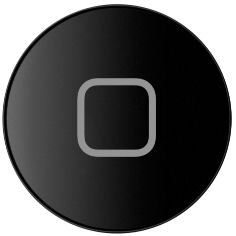

In Switzerland, Apple’s iPhone home button is considered not distinctive, but purely decorative.
The Federal Administrative Court in Switzerland recently ruled that Apple’s home button cannot be registered as a trademark as it lacks distinctive character. The Court did not find it evident that the mark had acquired distinctiveness. (Judgement B-2418_2014 of 17 February 2016).
Background of the case
Apple Inc. applied to the World Intellectual Property Organisation (WIPO) to register an international trademark consisting of a representation of the home button used on iPhones as shown above. The international registration (No. 1051626) has been accepted by most of the trademark offices it was designated for, including OHIM (registration no. 1051626).
OHIM originally objected to the registration on the grounds that the mark lacked distinctive character. However, they found the evidence raised by Apple Inc. sufficiently convincing to support a finding of acquired distinctiveness.
In Switzerland, the Swiss Intellectual Property Office refused trademark registration of the home button as they considered it to lack distinctiveness.
The decision of the Federal Administrative Court
The Federal Administrative Court confirmed the Swiss Intellectual Property Office`s refusal. They agreed that the graphic representation of the iPhone’s home button lacked inherent distinctive character and was thus not able to function as an indication of source of origin.
The Court reasoned that in general, shapes that consumers expect to be based on the function or aesthetics of the product will not be perceived as indication of origin. Apple’s home button is an integral part of the iPhone and the Court found that the consumers will perceive the shape of the button as being purely functional and decorative.
Apple tried to overcome the refusal by filing evidence showing acquired distinctiveness. Apple has a higher market share in Switzerland than across all member states of the European Union. Still, they did not succeed to prove that the home button could lead the consumer to perceive the indication of origin.
Apple argued that the placement of the home button centrally below the screen on the most popular electronic device in Switzerland could prove that it was used as a trademark. However, the evidence provided mostly concerned the marks “Apple” or “iPhone”, and not the home button as a mark. The Court ruled that the fact that the sign was used a part of the product did not demonstrate use of the home button as a trademark.
Furthermore, the Court agreed that trademarks usually can be found centrally below the screen on these types of products, but noted that this concerned traditional word or figurative marks and was thus not convinced of Apple’s arguing.
It is not certain whether Apple will appeal this decision yet.
Related
- "Neuschwanstein" is not a trademark!
- 1 December 2017: Madrid Monitor takes its place as the one and only tool for tracking international trademarks
- 1 January 2020 - Changes in Classifications - Trademarks, Designs, Patents and Utility Models
- 100th Anniversary of Bavaria (Germany) - A glance at trademarks, start-ups, innovation & events
- 10th Anniversary Edition - 10 Things to Know about LexDellmeier - Past, Present & Future
- 14 June 2013: Munich Patent Law Conference - Calculating Damages in Patent Infringement Cases
- 15 Top Brands - Interactive Brand Rating - Years 2000 - 2018
- 15 Years LexDellmeier - 2024 New Year Wishes
- 2014: Statistics for Community Trademarks
- 2024 World IP Day - Building Our Common Future with Innovation and Creativity
